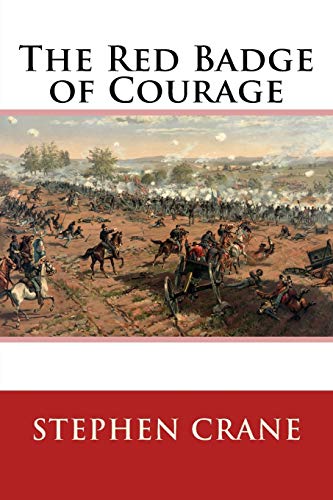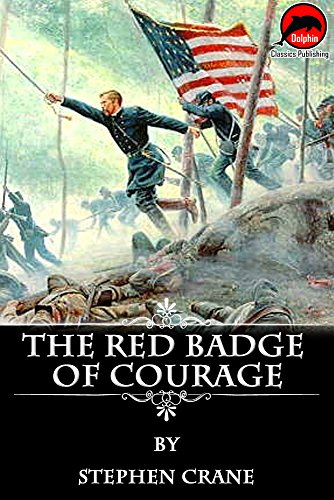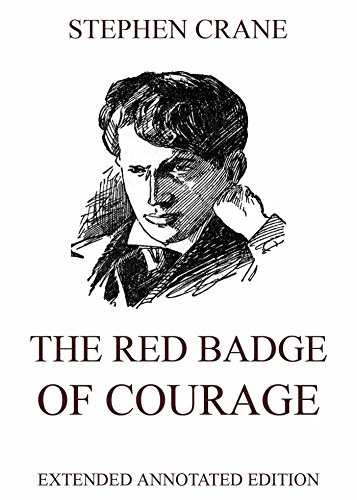-
The Red Badge of Courage
Stephen Crane
Paperback (CreateSpace Independent Publishing Platform, June 26, 2017)Young Henry Fleming has the romantic notions of the hero he will be when he enters his first battle, but his illusions are soon destroyed and he turns and runs. Ironically, he receives his ‘red badge’ when a fellow soldier strikes his head with the butt of a gun. He sees a friend die and tries to find security in a secluded spot in the forest...and so begins the true battle of the story, the one that rages inside's the hero's soul. V
V
-
Maggie: A Girl of the Streets
Stephen Crane
eBook (HarperPerennial Classics, Oct. 1, 2013)Originally published in 1893, Maggie: A Girl of the Streets tells the story of the impoverished Johnson family and their experiences living in the squalid Bowery neighborhood of New York City. When the eldest of the Johnson children, Maggie, commits an act deemed disgraceful by society, her life is tragically altered by the aftermath of the community’s rejection.Considered risqué at the time of its publication due to its strong, realistic themes, Maggie is now recognized as one of Stephen Crane’s best works, and is an example of one of the first instances of naturalism in American fiction.HarperPerennial Classics brings great works of literature to life in digital format, upholding the highest standards in ebook production and celebrating reading in all its forms. Look for more titles in the HarperPerennial Classics collection to build your digital library.
-
The Red Badge of Courage
Stephen Crane
eBook (Pandora's Box Classics, Dec. 12, 2015)A unique combination of performance and commentary. Topics include body language and camera angles; rehearsal vs. performance; set design, costume and make-up; and historical context. AVAILABLE ONLY IN NORTH AMERICA.
-
The Red Badge of Courage: An Episode of the American Civil War
Stephen Crane
eBook (First Avenue Editions TM, Aug. 1, 2014)A unique combination of performance and commentary. Topics include body language and camera angles; rehearsal vs. performance; set design, costume and make-up; and historical context. AVAILABLE ONLY IN NORTH AMERICA. V
V
-
The Open Boat and Other Stories
Stephen Crane
language (, April 9, 2020)Four prized selections by one of America's greatest writers: "The Open Boat," based on a harrowing incident in the author's life: the 1897 sinking of a ship on which he was a passenger; "The Blue Hotel" and "The Bride Comes to Yellow Sky," reflecting Crane's early travels in Mexico and the American Southwest; and the novella Maggie: A Girl of the Streets, a galvanizing portrait of life in the slums of New York City.
-
The Red Badge Of Courage
Stephen Crane
eBook (Jazzybee Verlag, July 1, 2014)A unique combination of performance and commentary. Topics include body language and camera angles; rehearsal vs. performance; set design, costume and make-up; and historical context. AVAILABLE ONLY IN NORTH AMERICA. V
V
-
Maggie: A Girl of the Streets
Stephen Crane
eBook (SMK Books, July 4, 2014)Maggie is "regarded as the first work of unalloyed naturalism in American fiction." According to the naturalistic principles, a character is set into a world where there is no escape from one's biological heredity. Additionally, the circumstances in which a person finds oneself will dominate one's behavior, depriving the individual of responsibility. Although Stephen Crane denied any influence by Émile Zola, the creator of Naturalism, on his work, examples in his texts indicate that this American author was inspired by French naturalism.
-
The monster and other stories. By: Stephen Crane.: The Monster is an 1898 novella by American author Stephen Crane
Stephen Crane
Paperback (CreateSpace Independent Publishing Platform, May 8, 2017)The Monster is an 1898 novella by American author Stephen Crane (1871–1900). The story takes place in the small, fictional town of Whilomville, New York. An African-American coachman named Henry Johnson, who is employed by the town's physician, Dr. Trescott, becomes horribly disfigured after he saves Trescott's son from a fire. When Henry is branded a "monster" by the town's residents, Trescott vows to shelter and care for him, resulting in his family's exclusion from the community. The novella reflects upon the 19th-century social divide and ethnic tensions in America. The fictional town of Whilomville, which is used in 14 other Crane stories, was based on Port Jervis, New York, where Crane lived with his family for a few years during his youth. It is thought that he took inspiration from several local men who were similarly disfigured, although modern critics have made numerous connections between the story and the 1892 lynching in Port Jervis of an African-American man named Robert Lewis. A study of prejudice, fear, and isolation in a rather small town, the novella was first published in Harper's Magazine in August 1898. A year later, it was included in The Monster and Other Stories—the last collection of Crane's work to be published during his lifetime. Written in a more exact and less dramatic style than two of his previous major works (Maggie: A Girl of the Streets and The Red Badge of Courage), The Monster differs from the other Whilomville stories in its scope and length. Its themes include the paradoxical study of monstrosity and deformity, as well as race and tolerance. While the novella and collection received mixed reviews from contemporary critics, The Monster is now considered one of Crane's best works. PLOT:After being admonished by his father, Dr. Ned Trescott, for damaging a peony while playing in his family's yard, young Jimmie Trescott visits his family's coachman, Henry Johnson. Henry, who is described as "a very handsome negro", "known to be a light, a weight, and an eminence in the suburb of the town",[20] is friendly toward Jimmie. Later that evening Henry dresses smartly and saunters through town—inciting catcalls from friends and ridicule from the local white men—on his way to call on the young Bella Farragut, who is extremely taken with him. That same evening, a large crowd gathers in the park to hear a band play. Suddenly, the nearby factory whistle blows to alert the townspeople of a fire in the second district of the town; men gather hose-carts and head toward the blaze that is quickly spreading throughout Dr. Trescott's house. Mrs. Trescott is saved by a neighbor, but cannot locate Jimmie, who is trapped inside. Henry appears from the crowd and rushes into the house in search of the boy, finding him unharmed in his bedroom. Unable to retreat the way he came, Henry carries Jimmie, wrapped in a blanket, to the doctor's laboratory and the hidden stairway that leads outside. He discovers the fire has blocked this way out as well and collapses beside Dr. Trescott's desk. A row of nearby jars shatters from the heat, spilling molten chemicals upon Henry's upturned face..... Stephen Crane (November 1, 1871 – June 5, 1900) was an American poet, novelist, and short story writer. Prolific throughout his short life, he wrote notable works in the Realist tradition as well as early examples of American Naturalism and Impressionism. He is recognized by modern critics as one of the most innovative writers of his generation.... V
V
-
The Open Boat and Other Stories
Stephen Crane
language (Xist Classics, March 14, 2016)Naturalism at Its Finest“If I am going to be drowned—if I am going to be drowned—if I am going to be drowned, why, in the name of the seven mad gods who rule the sea, was I allowed to come thus far and contemplate sand and trees?” - Stephen Crane, The Open BoatThe Open Boat is a true story about Crane’s traumatic experience of surviving a shipwreck. He along with other three men were stranded at sea for 30 hours before trying to reach dry land. Experience alongside the four characters what it really means to be on the brink, when not even God is able to save you. This Xist Classics edition has been professionally formatted for e-readers with a linked table of contents. This ebook also contains a bonus book club leadership guide and discussion questions. We hope you’ll share this book with your friends, neighbors and colleagues and can’t wait to hear what you have to say about it.Xist Publishing is a digital-first publisher. Xist Publishing creates books for the touchscreen generation and is dedicated to helping everyone develop a lifetime love of reading, no matter what form it takes. Get your next Xist Classic title for Kindle here: http://amzn.to/1A7cKKl Find all our our books for Kindle here: http://amzn.to/1PooxLl Sign up for the Xist Publishing Newsletter here. Find more great titles on our website.
-
Maggie: A Girl of the Streets
Stephen Crane
Paperback (Independently published, Nov. 19, 2018)Complete and unabridged.
-
Maggie: A Girl of the Streets
Stephen Crane
Hardcover (SMK Books, April 3, 2018)Maggie is "regarded as the first work of unalloyed naturalism in American fiction." According to the naturalistic principles, a character is set into a world where there is no escape from one's biological heredity. Additionally, the circumstances in which a person finds oneself will dominate one's behavior, depriving the individual of responsibility.
-
The Open Boat and Other Stories
Stephen Crane
eBook (, April 30, 2020)"The Open Boat" is a short story by American author Stephen Crane (1871–1900). First published in 1897, it was based on Crane's experience of surviving a shipwreck off the coast of Florida earlier that year while traveling to Cuba to work as a newspaper correspondent. Crane was stranded at sea for thirty hours when his ship, the SS Commodore, sank after hitting a sandbar. He and three other men were forced to navigate their way to shore in a small boat; one of the men, an oiler named Billie Higgins, drowned after the boat overturned. Crane's personal account of the shipwreck and the men's survival, titled "Stephen Crane's Own Story", was first published a few days after his rescue.Crane subsequently adapted his report into narrative form, and the resulting short story "The Open Boat" was published in Scribner's Magazine. The story is told from the point of view of an anonymous correspondent, with Crane as the implied author, the action closely resembles the author's experiences after the shipwreck. A volume titled The Open Boat and Other Tales of Adventure was published in the United States in 1898; an edition entitled The Open Boat and Other Stories was published simultaneously in England. Praised for its innovation by contemporary critics, the story is considered an exemplary work of literary Naturalism, and is one of the most frequently discussed works in Crane's canon. It is notable for its use of imagery, irony, symbolism, and the exploration of such themes as survival, solidarity, and the conflict between man and nature. H. G. Wells considered "The Open Boat" to be "beyond all question, the crown of all work".